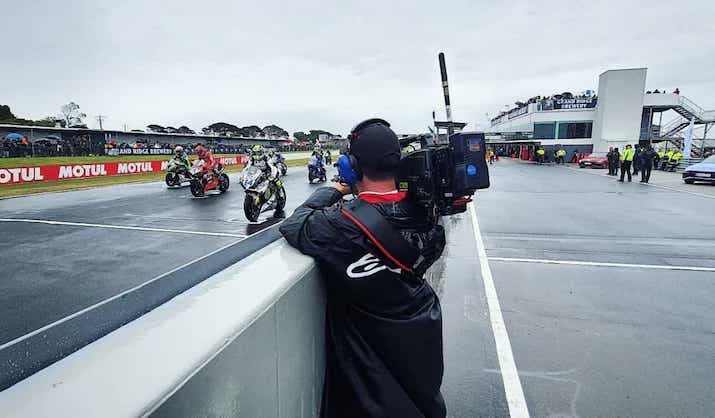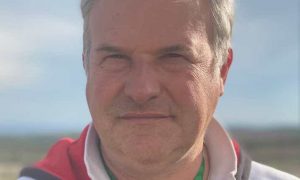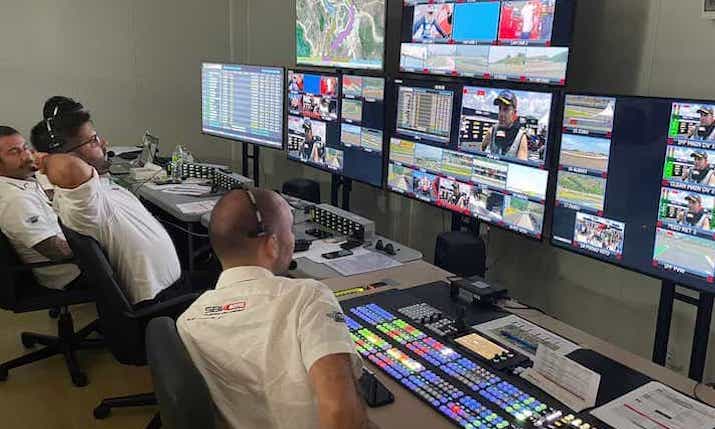EMG Italy and Dorna Sports end another exciting World Superbike season with success in Australia

The 2022 Superbike World Championship (WorldSBK) season, which started in April and ended in October, featured teams from around the world, including Spain, the Netherlands, Portugal, Italy, the United Kingdom, Czech Republic, France, Argentina, Indonesia and Australia. As a sport with such global appeal, the last three rounds of the WorldSBK season were held outside of Europe, concluding at the Phillip Island Grand Prix Circuit in Victoria, Australia.
Shortly after this final event, which was won by Ducati, SVG Europe spoke to Luca Manfredi, EMG Italy technical manager for the non-European legs of WorldSBK, to find out more about the technical set up on the track this year.

Luca Manfredi, EMG Italy
EMG Italy has been following SuperBike and its exciting international competitions for 12 years. What technological innovations have been introduced for this edition?
In the just concluded 2022 season, at least two significant innovations were introduced: the first, a television production system which has embraced progressive, in HD 1080p SDR, making it more suitable for distribution to traditional television as well as OTT. We’ve also increased the number of onboard micro cameras on Dorna’s proprietary bikes.
The SBK season takes place in Europe and overseas. Does EMG Italy use the same technical setup and configurations for all the rounds?
EMG Italy generally follows the entire Superbike championship for Dorna with the Nova 126 OB truck for the European rounds. For the overseas ones, such as Argentina and Indonesia, the same technologies on board the mobile unit are inserted in flight cases in a sort of mirroring configuration.
In general, the SBK standard includes 20 Sony HDC4300 cameras – two of which work in 8x for HFR slow motion – five EVS XT3 systems, three XFile3 systems for ingest and playout, and an onboard system that manages up to seven groups of three RF micro cameras on the bikes. These are proprietary Dorna cameras.
Each bike has three remotely controlled micro cameras on board, the images of which are switched, usually on the straightway of the track, by Dorna operators.
Is the fibre cabling of the circuits and all the RF management usually complex in SBK?
In all circuits, both European and overseas, EMG Italy carries out all the cabling with fibre backbones of the circuit and also lays an optical fibre ring that covers the entire route with five antennas, which are dedicated to receiving the signals from the onboard micro cameras.
Each bike has three cameras on board and a transmitter that multiplexes the signals; up to seven bikes are controlled by radio. The whole system uses Vislink Gigawave connection devices.
The cameras on board the motorbikes are installed exclusively by a Dorna mechanic, the only one to be authorised, given that there are weights to guarantee and safety in the wiring to be respected.
In addition to this, three RF cameras are also set up in the pit lane. Two cameras shoot from the pits with Vislink radio link while a third radio link connects a full frame camera mounted on a Ronin support for unique stabilised shots.
Tell me about the galleries, and how are the flight cases and the TV compound organised?
The entire television production system travels protected in seven flight case modules which interconnect at the destination to form the main gallery. The central gallery is based on a Grass Valley Kahuna 9600 video mixer and is set up inside the TV compound and IBC of each circuit.
The director, the video mixer, the person in charge of switching the onboard cameras and the assistant director work here.
The only difference in technical setup is in the matrix: it’s Grass Valley Vega in the flight case gallery, while the one onboard the Nova 126 truck is from Imagine Communications.

Behind the gallery are the marketing and content management departments, as well as the editorial staff and journalists.
A separate gallery is set up in a second container to host EVS operators. This solution, created to comply with anti-COVID regulations, has remained operational even afterwards because it is considered convenient and effective.
All the telemetry control, which follows the radio frequency connected to the onboard cameras on the bikes, is managed in a dedicated container.
Also located in the TV compound is the main office. This is set up to allow for the control and management of streaming to Barcelona and the delivery of signals to the uplinks that deal with the delivery of the main signals. Transmission backup is done via fibre.
I imagine a team of specialists from EMG Italy is needed, given the complexity and the high number of circuits. What improvements have been introduced at the technical setup level?
Fabio Merulla takes care of the technical management of the European SBK competitions, while I take care of the overseas races, with a team of 18 people from EMG Italy.
EMG Italy manages the technical setup, the on-venue cabling, the assembly of all the cameras on the circuit and the certification of the system.
Compared to previous years, architectures with progressive signals have been implemented with EVS and Sony cameras, and all connections are in optical fibre.
The rather complex setup includes 20 cameras along the course for the overseas rounds and 22 for the European ones. The positioning allows for continuity of the race from close points of view in the most interesting corners; eight Supermotion cameras are installed in the more technical chicanes, which allow for slow motion.
All cameras are equipped with Canon 80x long optics and the one installed on the Ronin enables portrait-style shots with a more visible subject and a more evident detachment between the frontal image and the background, which appears deliberately more blurred.
The entire communication and signal transport setup is created with fibre optic backbones, including the HF ring dedicated to the radio cameras, and each circuit is wired by interposing six hubs where all the signals converge for sorting. Then, from these locations, the connection to the cameras takes place on SMPTE cables.
Setup starts on Monday. The complete system is delivered on Thursday, given that free practice starts on a Friday and the two races take place on Saturday and Sunday.
The Nova 126 mobile unit used for SBK Europe was one of the first to be built with three expansions in Italy and set the pace in terms of the best ratio between performance and size. It is highly appreciated for its comfort and reliability, for the separate areas, for the presence of the double gallery and for its double entrances: it’s excellent in the case of simultaneous use as host broadcaster and for unilateral customisation.
All communications are handled by Riedel systems with 11 beltpacks via Bolero radios, and audio is controlled by a DiGiCo SD7 console.
All audio is recorded in stereo with Audio-Technica and Sennheiser audio-follow-video microphones, positioned in a double configuration for each camera, and some placed along the straights. Each on board camera has its own internal microphone which picks up very effective sound.
